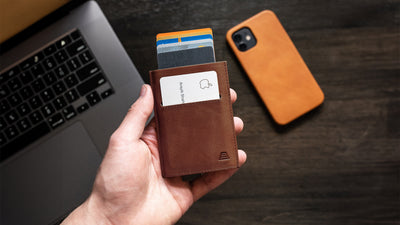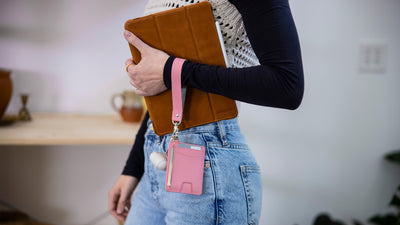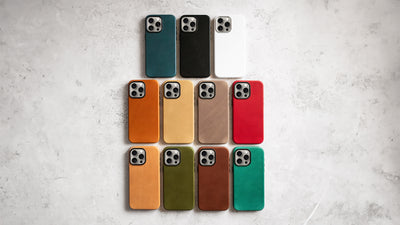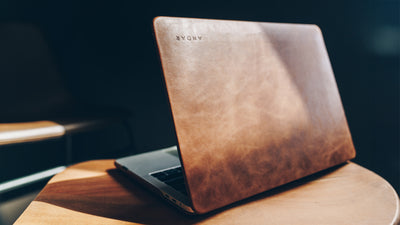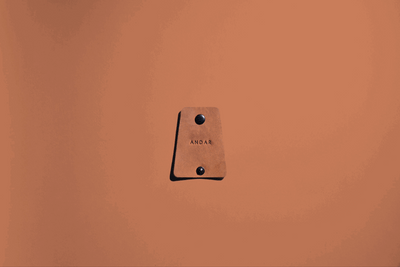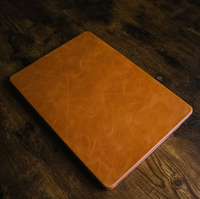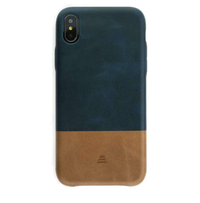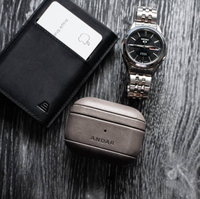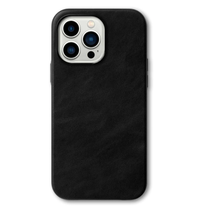The Blog
What Is Bonded Leather: The Most Important Things To Know

Learning about leather is like spelunking a dark cave for hidden gems. Every time you shine your spotlight in another corner, something new is revealed, something you haven’t seen before. Perhaps you’ve heard of full-grain leather and suede. They are pretty common types of leather used for all sorts of products, including wallets, bags, purses, and shoes.
At this point, you’ve heard of genuine leather and its broad demarcation of any material which is stitched together from disparate pieces of leather to form one large piece that’s then painted over to give the look of one unified cut of hide.
If you’ve been exploring especially enough, then you’ve probably heard of Nappa leather too, known for its incredibly soft texture and supple flexibility. Perhaps you know about aniline and semi-aniline leather as well, and the special process it undergoes to finish the hide, giving it that vibrant look.
And should you have exhausted the above nooks and crannies, you may possess a bit of knowledge about those leathers which look like leather but aren’t. You’ve found out about PU leather (polyurethane) and its vinyl counterpart.
These are faux leathers or fake leathers that are made from melting a flexible polymer onto cotton or polyester to construct a flexible but durable material that looks and acts like leather. After all, PU leather even wrinkles like genuine leather!
The one misfit is bonded leather. What actually is bonded leather? Is it authentic leather or is it faux? Or something in between? How does it compare to authentic leather? And what is it used for?
Defining Bonded Leather
Bonded leather sits in the liminal space between synthetic and genuine leathers. It’s not quite either, and hence has its own category to define itself. Bonded leather is a near synthetic leather––it is not faux leather, because it contains genuine leather fibers in its construction, but it’s not real leather because it is a product designed and made by humans rather than sourced purely from a cut of animal hide.
In other words, bonded leather is made from leather fibers that are ground down and bonded with polyurethane, then attached to an artificial backing like paper or fiber. An apt equivalent is particle board. Yes, particle board is real wood, but it's the shredded wood fibers compressed and glued together to make a uniform board.
Similarly, these leather fibers are shredded and ground, then mixed with the polyurethane to give it a structure and flexibility similar to the genuine article. As far as EU standards go, bonded leather must be 50% authentic leather fibers to be considered bonded leather. The difference between bonded leather and PU is that the former uses authentic leather particles, while the latter merely employs cotton or polyester, etc. instead.
You will find bonded leather most common in furniture and upholstery, bags and backpacks, and book or journal binding, along with an assortment of accessories. But why did we start making bonded leather? What are its advantages and disadvantages when compared to authentic leather hide?
Bonded Leather Compared: Benefits
Bonded Leather Reduces Waste
Like suede, which ingeniously takes a damaged piece of hide and turns it over to use the underside instead, bonded leather recycles damaged and unused pieces of hide to make usable leather pieces. What happens with all the small cuts that are tossed away?
All the torn and leftover scraps of leather that would be thrown away are now turned into bonded leather. They are gathered together, “blended” and reduced to fibers to construct bonded leather. This reduces the amount of waste produced by the tanning industry, which contributes to a more sustainable environment.
Bonded Leather Is Incredibly Versatile
Because bonded leather, despite using real leather leftovers, is a humanly engineered product, its expressions are endless. Bonded leather’s appearance is indebted to stamping the leather grain onto the material after it is finished.
This means that it can come in almost any pattern imaginable, including the normal grain of authentic leather, snakeskin, scales, or any design at all. Likewise, it comes in a plethora of colors, which many enjoy. While typical leather only comes in different variations of brown and black, bonded leather comes in as many colors as the rainbow (and perhaps more).
Bonded Leather Is Cost-Effective
Because bonded leather reuses the leather scraps that would otherwise be disposed of, it is cheaper than a full-grain cut of hide, since full-grain leather comes from just one piece of hide, and not a bunch of smaller pieces either sewn together or ground-up. Because it looks and smells like real leather it found a vast market in consumer goods and furniture due to its much cheaper cost.
Bonded Leather Compared: Disadvantages
Bonded Leather’s Lack of Durability
Because of the plastic that is used in the blending process of making bonded leather, it is not as durable as natural leather. The plastic used isn’t as flexible as animal hide, and can crack or peel in just a few years of use. Bonded leather isn’t intended to be an heirloom item that can last a lifetime or more.
On this count, if you’re investing in a leather item and want it to serve you for many years to come, bonded leather will fail. Bonded leather is great for a budget, and because of its remarkable similarity to genuine leather, it is an affordable alternative. But genuine leather—especially full-grain leather—will outlast a bonded leather item for a long time, even a lifetime.
Bonded Leather Doesn’t Patina
A full-grain leather product will age with you and individuates with your travels. Its rich patina develops and matures with more time and use. Regrettably, because bonded leather is a mixture, it won’t age uniquely alongside you as full-grain leather does.
Bonded Leather vs. Genuine Leather
When broken down like the above, bonded leather is a great product for its set of intentions. It is a cheaper alternative to authentic full-grain leather that avoids some of the pitfalls of faux leathers like PU leather and vinyl synthetics.
On the one hand, bonded leather is leather. It simulates the grain and wrinkles of normal leather, and even possesses the smell of genuine leather. And it has the added benefit of reusing the scraps of genuine leather that would otherwise be wasted. Instead of disposing of these leftovers, they are reincorporated to make entirely new products.
In addition, bonded leather avoids the artificial look of vinyl, and wins out the durability contest with PU leather, because it uses genuine leather instead of cotton or another fabric. For all of this, bonded leather should be praised.
With less expensive products, however, there often comes some or other non-monetary costs. Here, the cost is durability. Because bonded leather is constructed from a lot of smaller pieces blended together—sourced from all different cuts of leather that can be of any quality—bonded leather deteriorates far quicker than genuine leather.
Conclusion
So, if you are looking for a couch for your dorm room, then a bonded leather product is perfect, and often the best option. But if you are looking to invest in a wallet that you’re planning to carry with you for the rest of your days, or a backpack that can handle the adventures you plan on going on, then full-grain leather is the best fit. We suggest Andar’s meticulously designed leather cream to keep all your leather products safe.
Conditioning your leather is a must to restore the moisture of your leather item in order to keep it from cracking or wrinkling and to emphasize its patina.
Sources:
Bonded Leather Standards | European Committee for Standardization
Bonded Leather | Leather Dictionary
Bonded leather vs. Faux leather – What is the difference? | Furniture Blog
